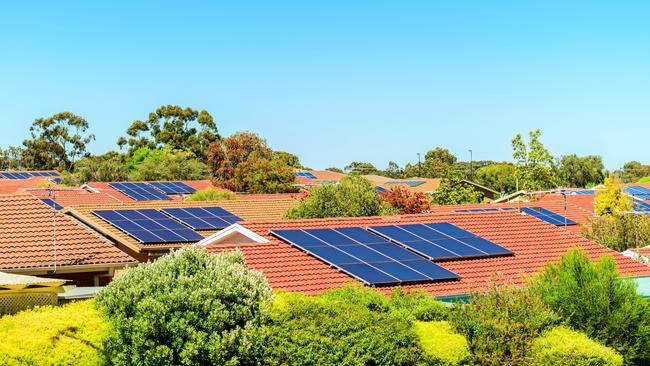$1.3bn hit as subsidies for solar panels surge
Rooftop solar installation subsidies will exceed $1bn this year and drive up power costs by $100 per household.

Energy consumers will be forced to pay more than $1 billion for rooftop solar installation subsidies this year, increasing power costs by up to $100 per household, according to an industry analysis.
Operators warn of a spike in the number of unscrupulous operators unless the green-power subsidy is wound back.
The Clean Energy Regulator has released figures showing that more than 1057 megawatts of capacity was installed last year, equating to 3.5 million solar panels being fixed to rooftops.
Industry analysis obtained by The Australian reveals the cost of small-scale technology certificates — created to increase the incentive to install rooftop solar — shows the value of the subsidies was $500 million last year.
The solar industry is expecting the subsidy to increase to about $1.3bn this year after the regulator estimated in January that 22 million new certificates would be created over the year.
The certificates are granted to people installing solar panels, and electricity retailers are required to buy them.
Jeff Bye, founder and owner of Demand Manager in Sydney, a company that creates and trades the certificates, warned that the rebate was “overly generous” in many circumstances. “There are strong reasons to support installation of rooftop solar in Australia; however, it’s a question of the degree of support needed,” he said.
“The cost increase (this year) is about $800m and there are 8 million households … so there’ll be a cost impact of around $100 per household. The electricity impact might be $40 or $50 per household but businesses will pass through the additional cost too … That subsidy of $500m last year, or $1.2bn to $1.3bn this year, is added on to everyone’s bills.”
Energy Minister Josh Frydenberg said the Australian Energy Market Commission had found the average cost to households over the past five years was about $29 a year, with the price peaking in 2012 at $44 for the year. “The AEMC forecasts residential electricity prices will fall over the next two years as renewable energy, including small-scale solar supported by the Renewable Energy Target, enters the system,” Mr Frydenberg said.
In last year’s Residential Electricity Price Trends report, the AEMC acknowledged that “costs incurred in purchasing certificates are assumed to be passed on to consumers through retail prices”.
Mr Frydenberg celebrated the solar rooftop take-up last year, saying Australia had emerged as a “world leader” and noted that one in five households used solar power.
NSW Liberal MP Craig Kelly, chairman of the Coalition backbench committee for energy and the environment, warned that the cost of rooftop solar subsidies was being carried by those who could least afford it.
He said the benefits of lower power prices were going to high-wealth households that installed the panels, while those without solar panels were hit with higher prices passed on by electricity retailers.
“It’s effectively a reverse Robin Hood scheme where we are increasing the electricity prices on the poor to reduce electricity prices for the rich,” Mr Kelly said.
“A woman rang me during the week and broke down on the telephone. She just got her electricity bill and it was $800. She was expecting a bill of $400 ... she’s got no way of paying for it.”
Mr Frydenberg faces calls to reduce rooftop solar subsidies by slashing the price of the certificates that electricity retailers are required to buy. He is expected to set a target for the calendar year by the end of this month.
Mr Bye said the number of certificates to be bought each year was set by the small technology percentage (STP), but warned the system was flawed and the certificates were overpriced.
“In recent history, the certificates have traded close to the maximum legislated price of $40 and the target-setting process, overseen by the minister, effectively leads to a continuation of that pattern,” Mr Bye said.
“However, there was a period last year when the market price dropped to $30 but the boom in solar installations continued.”
Mr Bye warned that the high STC price, coupled with growing demand for solar, could attract “unscrupulous operators”.
“It’s nowhere near what it was 10 years ago under the home insulation program but we should be wary of subsidies attracting the wrong people,’’ he said.
Governor-General Sir Peter Cosgrove travelled to New Delhi at the weekend to represent Australia at the International Solar Alliance Founding Conference after a request was made by Prime Minister Malcolm Turnbull.






